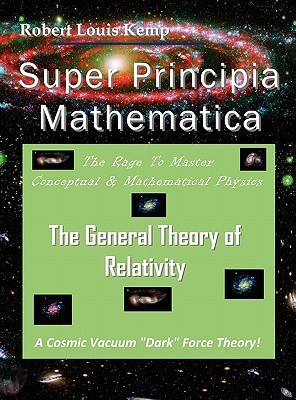Title: Super Principia Mathematica: The Rage to Master Conceptual & Mathematical Physics – The General Theory of Relativity
Author: Robert Louis Kemp
Publisher: Flying Car Publishing
ISBN: 9780984151820
Pages: 544, Hardcover
Genre: Reference/Science-Math/Education
Reviewed by: Gary Sorkin, Pacific Book Review
Book Review
This is not an ordinary book and extraordinary would still be an understatement. Robert Louis Kemp has built a plateau of quod erat demonstrandum (Q.E.D.) in math, physics and logic; defined as his Super Principia Mathematica. Beyond brilliant, Kemp has worked on his book for over two decades, sacrificing personal comfort and financial security to laboriously bring to fruition his textbook style, hardback, expertly illustrated principles to the understanding level prevailed by most people. By “most people” he means those who have a basic understanding of mathematics, geometry, algebra, calculus, physics and most importantly possessing the curiosity to learn.
Kemp unpretentiously begins with a quick introduction of the laws of physics, math, relativity, quantum mechanics, and other issues regarding creation of matter, the beginning of the universe, plus dark energy, particle physics, atomic energy, geometry, time and space. In doing so he credits the groundbreaking work done by others over the centuries, such as; Nicolas Copernicus, Jonannes Kepler, Rene Descartes, Isaac Newton, and more recently Michael Faraday, Albert Einstein, Hendrik Lorentz, Alexander Friedman and the contemporary and controversial work of Steven Rado. However most notably Robert Louis Kemp celebrates the work and wisdom on one which he quotes throughout his prose and cites credit beyond all the others, and that is God. I would not classify this book within the genre of theology; however it is refreshing to see a man with such scientific acumen articulate his respect for a fundamentally diametrically opposing thought process.
It would be impossible to describe the scientific descriptions of Kemp without quoting an excerpt from his work to illustrate the nature of his writing. Halfway into this book he talks about the principles of The Vacuum Force. To quote, “The Vacuum Force is popularly thought of as an attractive effect, which is incorrect since vacuums do not innately attract matter like Gravity does using mass. The Vacuum Force behaves similar to a home vacuum where the dust being “sucked” into a vacuum cleaner is actually being pushed in by the higher pressure air on the outside of the cleaner.” Kemp then goes into a discussion of the suction of fluids, which quite interestingly, “… if the pressure is inward (centripetal) motion, its motion does not follow a straight (radial) path to the center; it follows a spiraling path; this is called a vortex.” This is brought deeper into the discussion of the forces of the vacuum, the effect of “zero-point energy,” called the Casimir Effect, proposed by Dutch physicist Hendrik B. G. Casimir. “In quantum field theory, the Casimir effect and vacuum force are physical forces arising from a quantized field.” Kemp further goes on to show the relationships using algebraic equations.
An analytical critique of the examples of Robert Louis Kemp’s work in a book review is like taking all of Mozart’s music and summarizing it into a 30 second sound bite. Kemp writes concisely and cohesively on Einstein’s Theory of Relativity, further explaining the relationships of gravitational force, energy, matter and time with countless drawings, equations, and formulas. This book is not to be read in one sitting, but to be savored, chapter by chapter preferably by a discussion group or class, and used as a foundation for further discovery. I have found nothing to contradict or state any opposing comments.
I will reiterate the tools described by Kemp, as stated in his Prologue, “For me, the mathematics of physics, are the tools that God gave man that he may understand, describe, and predict the great works of God’s created universe.” This textbook style book has hundreds of “white board” equations, numerous expertly diagramed illustrations, and an index precisely affording the reader access to the points of reference within the text by subject. The reader will understand the relationships between such abstract forces and be able to compute the solution of an unknown variable based upon known formulas. His work is recommended for college level classroom studies, independent learning, and as a satisfying source of information for the curiosity within all of us. Robert Louis Kemp takes these tools and in this, one of his series of publications, Super Principia Mathematica: The Rage to Master Conceptual & Mathematical Physics -The General Theory of Relativity becomes a man and with a clear, cognitive vision describing God’s universe to all fellow men.


